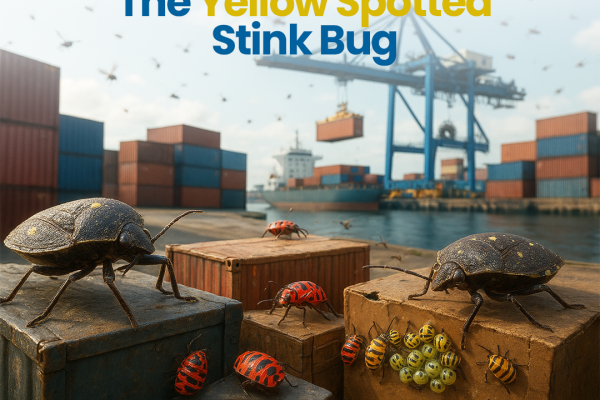Biosecurity plays a critical role in the duties of the modern-day Customs Broker and, as our importing clients have come to learn, we must be ever vigilant to the threat of insects now commonly called ‘hitchhiker pests.’ These the exotic bugs hitch a ride to Australia in timber, bamboo, wooden products, in crates and other packaging, and inside shipping containers.
You may already be familiar with the brown marmorated stink bug (BMSB), but the new player on the scene is its dotted cousin, the yellow spotted stink bug (YSSB).
The YSSB now joins this growing list of hitchhiker pests:
– Brown Marmorated Stink Bug (BMSB)
– Khapra Beetle
– Burnt Pine Longicorn (BPL)
– Flighted Spongy Moth Complex (FSMC) – a.k.a. Asian Gypsy Moth (AGM)
– Giant African Snail
The YSSB (scientific name Erthesina fullo) is an invasive insect that is considered a serious biosecurity threat to agriculture in countries outside its native Asian range, such as Australia, New Zealand, Europe, and the Americas. It is a significant plant pest that damages fruit crops and ornamental trees.
In parts of China, YSSB has already become a significant agricultural pest, damaging crops such as kiwifruit, pear, macadamia, and others. The stink bugs feed on the leaves, flowers, shoots, and fruit, creating entry points for plant pathogens to infect the plants.
Following a spike in border detections during the 2023–24 season, the YSSB was added to Australia’s National Priority Plant Pests list by the Department of Agriculture, Fisheries and Forestry (DAFF). Like BMSB, this pest poses a serious biosecurity risk due to its ability to rapidly form huge populations and cause damage to a wide range of crops.
In mid-2024, a technical response director from DAFF visited a quarantine facility in Switzerland called the Centre for Agriculture and Bioscience International (CABI), where researchers are rearing YSSB to study its lifecycle and behaviour. Together with a CABI researcher, they then travelled to Durres, Albania, a port city heavily infested with YSSB. There, they observed feeding habits and noted that large-leaved linden trees and oriental plane trees—commonly used in Australian street planting—were among the bug’s preferred hosts.
Thanks to these international collaborations and research efforts, DAFF is now better placed to detect and respond to YSSB and protect our crops and environment from the devastation this pest has caused overseas. These learnings and insights will also be incorporated into the review of the National Hitchhiker (Contaminating) Plant Pest Action Plan – which provides a national collaborative approach to preparedness for hitchhiking pests.
It is critical to manage the risk of these pests – they may be harmful to our environment and economy if they enter Australia, spread, and become established.
Australia enjoys freedom from many of the world’s most damaging pests and diseases. The best protection is to be prepared to detect exotic pests and diseases right at our borders.
Colless Young provides a complete range of customs clearance services including quarantine. For more information about Biosecurity procedures, treatments and charges, contact Andrew, Tel: +61 7 3890 0800 email enq@collessyoung.com.au .

